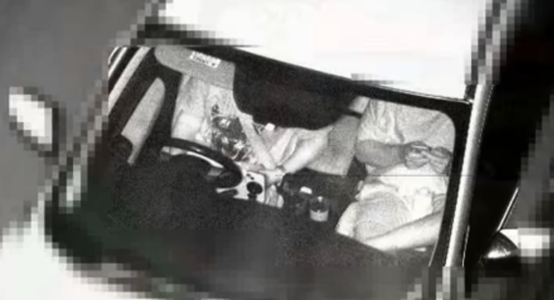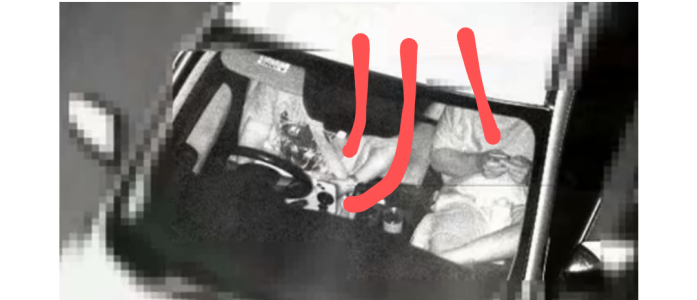Mum battles $410 fine from secret new cameras—are you at risk too?
By
- Replies 34
In a world where technology is increasingly intertwined with our daily lives, it's no surprise that even our roads are under the watchful eye of advanced surveillance systems.
But what happens when these systems, designed to keep us safe, make a mistake?
This is the dilemma faced by a Sydney mother who found herself on the wrong side of a new seatbelt detection camera and was fined a hefty $410.
April Miller and her husband were returning from a family visit to the Blue Mountains when they were caught off guard by a fine in the mail.
The notice claimed that their seatbelts were not being worn correctly, a severe offence in New South Wales that carries a financial penalty and three demerit points.
The twist? April is adamant that she and her husband were wearing their seatbelts properly, as evidenced by the camera's photo.
'We came back to a fine in the mail (claiming) our seatbelts weren’t on correctly,' she said.
'In the corner, you can clearly see that we have our seatbelts on, both of us.'
'If you’ve broken the law, you’ve broken the law, but if you haven’t and there’s no reason for it, then that is frustrating.'
The introduction of seatbelt detection cameras in NSW on 1 July aimed to reduce the number of road fatalities.
With seatbelt noncompliance involved in 15 per cent of road deaths each year in the state, the need for enforcement is clear.
Despite rejecting her initial appeal, April is not giving up the fight.
She's rechallenging the system, determined to prove that she and her husband were wrongly fined.
The situation has sparked a broader conversation about the reliability of artificial intelligence (AI) in law enforcement and the importance of having a fair and transparent review process.
Transport for NSW Centre for Road Safety executive director Bernard Carlon acknowledged that while AI is used to identify potential offences, human oversight is crucial.
'There can always be human error, and we want to have a system that’s fair,' he said.
In the five months since the cameras were introduced, nearly 50,000 fines have been issued.
'There’s a massive reduction in the number of people offending, that’s really good,' Carlon claimed.
The government insists the system is effective, citing a significant drop in seatbelt-related offences from over 16,500 in July to around 9,800 in October.
This suggested that driver behaviour is indeed changing for the better.
However, Shadow Transport Minister Natalie Ward echoed the concerns of many motorists when she said, 'Fining motorists who do the right thing is unacceptable because it reduces community confidence.'

Have you had any experiences with these new seatbelt detection cameras? Do you think they are an effective way to improve road safety, or do they pose a risk of penalising law-abiding citizens? Share your thoughts and any advice in the comments below.
But what happens when these systems, designed to keep us safe, make a mistake?
This is the dilemma faced by a Sydney mother who found herself on the wrong side of a new seatbelt detection camera and was fined a hefty $410.
April Miller and her husband were returning from a family visit to the Blue Mountains when they were caught off guard by a fine in the mail.
The notice claimed that their seatbelts were not being worn correctly, a severe offence in New South Wales that carries a financial penalty and three demerit points.
The twist? April is adamant that she and her husband were wearing their seatbelts properly, as evidenced by the camera's photo.
'We came back to a fine in the mail (claiming) our seatbelts weren’t on correctly,' she said.
'In the corner, you can clearly see that we have our seatbelts on, both of us.'
'If you’ve broken the law, you’ve broken the law, but if you haven’t and there’s no reason for it, then that is frustrating.'
The introduction of seatbelt detection cameras in NSW on 1 July aimed to reduce the number of road fatalities.
With seatbelt noncompliance involved in 15 per cent of road deaths each year in the state, the need for enforcement is clear.
However, April's case raises concerns about the accuracy of these cameras and the processes in place for disputing fines.Despite rejecting her initial appeal, April is not giving up the fight.
She's rechallenging the system, determined to prove that she and her husband were wrongly fined.
The situation has sparked a broader conversation about the reliability of artificial intelligence (AI) in law enforcement and the importance of having a fair and transparent review process.
Transport for NSW Centre for Road Safety executive director Bernard Carlon acknowledged that while AI is used to identify potential offences, human oversight is crucial.
'There can always be human error, and we want to have a system that’s fair,' he said.
With two human reviews following the AI's assessment, the system is designed to minimise mistakes, but as April's case shows, errors can still occur.In the five months since the cameras were introduced, nearly 50,000 fines have been issued.
'There’s a massive reduction in the number of people offending, that’s really good,' Carlon claimed.
The government insists the system is effective, citing a significant drop in seatbelt-related offences from over 16,500 in July to around 9,800 in October.
This suggested that driver behaviour is indeed changing for the better.
However, Shadow Transport Minister Natalie Ward echoed the concerns of many motorists when she said, 'Fining motorists who do the right thing is unacceptable because it reduces community confidence.'
Key Takeaways
- Sydney mother April Miller, is appealing a $410 fine for allegedly not wearing her seatbelt properly, detected by a new camera system.
- Despite being visible in the photograph sent with the fine, her initial appeal was rejected, but she is trying again.
- Seatbelt compliance is critical in NSW, where 15 per cent of road deaths yearly involve people not wearing seatbelts correctly.
- Transport for NSW acknowledges the potential for human error in the seatbelt detection system and emphasises a fair process, while the government claims driver behaviour is improving with reduced offences.
Last edited by a moderator:









